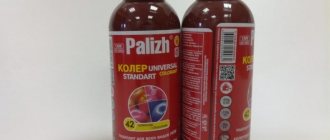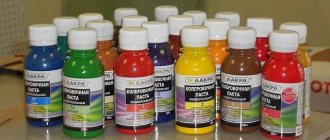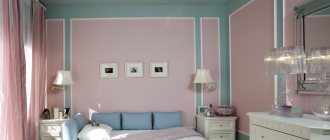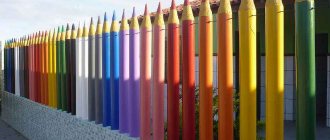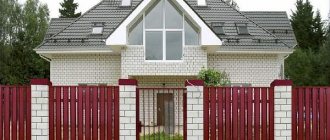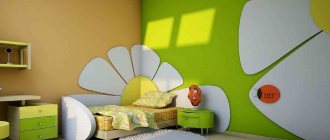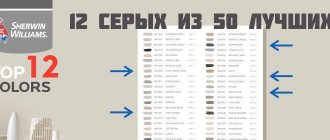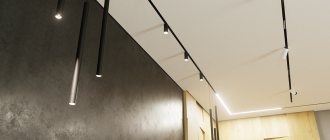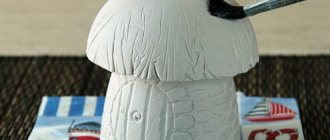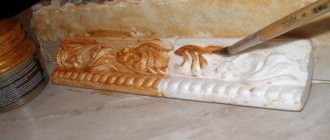When carrying out renovations, painting work often requires tinting the paint in the desired color range. You can achieve the desired tone by mixing several paints that are similar in composition, but it is easier to use special tinted pigments. First, about the concept of “paint tinting”, this is the procedure of mixing an acquired type of paintwork material with pigments in the form of powder, paste or thick paint.
What kind of paint is this and what is it for?
Attention
Kohler is a rich and bright paint with high pigmentation and good miscibility with the base. Needed to give the required shade to the base paints (they are initially white). Any type of paint is used as a basis for tinting, but choosing a color for it is more difficult.
The tinting process can be carried out either with special equipment or manually, at home.
- With a mechanized method, an exact shade can be achieved. This is necessary to tint several cans or match the color to an already painted surface.
- Tinting at home is a simple process and saves time on traveling to tinting centers.
It can be of any consistency, but more often it is in the form of a paste or thick paint. Powdered formulations are also available. Coloring properties are achieved by adding organic and inorganic pigments to the composition. The first option often prevails, as it is more saturated. But organic pigment is less lightfast than inorganic pigment.
Basic methods of tinting paints
Each master independently decides how to tint the paint. For the convenience of users, leading manufacturers have developed color cards with codes for each tone. Consumers order the desired coating color from the catalog, choosing the degree of gloss or matte.
For the convenience of users, leading manufacturers have developed color cards with codes for each tone.
Using equipment
Ready-made paint mixtures are tinted in specialized stores using automatic machines with liquid colorants. To do this, the buyer does not need to know what tinting is. Just select the desired tone.
Advantages of using automatic machines:
- Maximum accuracy of dye dosage;
- Simultaneous tinting of a large batch is possible;
- Speed of the procedure;
- The recipe is identical; if there is not enough paint mixture, you can buy more composition after some time.
It’s a pity that such machines are not delivered to your home or site; you have to make the mixture yourself.
Just select the desired tone.
Manually
Details of how colors are used are described below. Manual tinting involves stirring a certain portion of dye in jars using devices. It is possible to obtain a unique color only by sampling.
To get the same color, you will have to find a large container to tint all the paint at once.
To get the same color, you will have to find a large container to tint all the paint at once.
Photos of color and design options
Further in the photo you can see samples from the color catalog and design options for the completed work.
Is it possible to paint a wall surface?
To paint a small fragment of a wall, you can use a color scheme. The use of such a product over large areas is irrational for two reasons:
- Big expense . The product is sold in small containers. In terms of regular paint it turns out to be very expensive.
- Poor application . This reason is due to the density of the composition. For drawing small and clear details this will be a plus, but for painting large surfaces it will be a minus.
How to choose?
Let's consider how best to choose the appropriate color scheme and what you need to focus on. Selection criteria taking into account characteristics:
- Manufacturer . Despite prejudices, a domestic manufacturer can offer a product that is no different in quality from a foreign one. And its price will be significantly lower. If the base paint has already been purchased, then it is advisable to take the color from the same company.
- Tara . It is more convenient to use packaging with a narrow neck, this makes it much easier to pour the required volume.
- Type of base paint . The most popular option is for water-based emulsion. This doesn't mean there aren't options for other foundations. But finding them on the market will not be easy.
- Availability of shade map . Almost every manufacturer has such brochures; it is much easier to select the desired shade from them. It is better to check with the seller when purchasing whether such a card is available.
- Hue . Depending on the lighting, the finished shade may look different in different rooms. The recommendation is not to mix the entire volume of the base at once, give it time to “get used to” the shade and make possible adjustments.
- Pigment type . They are organic and synthetic. For a well-lit room, it is better to choose a product with a synthetic pigment, as it is less susceptible to fading in the sun. Under artificial lighting, organic pigment looks better: it is more saturated and has natural, “pure” colors.
What is tinting and why is it needed?
In essence, tinting is giving paints and varnishes the required shade or color using special compounds. Color selection is done manually or automatically. The program independently carries out calculations based on the specified tone. The machine pours the required amount of dyes into a can of white paint or enamel.
When you need to tint something, you have to tint the mixture manually. This is a long process that requires attention. Comparing old and new coatings should take into account several rules:
- You need to wait until the sample dries well.
- A small painted area and a larger area appear to be a different shade.
- When applied vertically and horizontally, the same tinted paint will look different.
- Under artificial lighting, cool colors become a shade darker, warm colors have a yellowish tint, and the range of red tones becomes brighter.
When choosing a color, you should take into account the geometric features of the room and the functional purpose of the rooms.
Tinting is giving paints and varnishes the required shade or color using special compounds.
How to properly dilute?
The process of mixing color is an important step when painting. For the best result, the following technology must be followed:
- You need to dilute the color in a clean container, for example, take a plastic or enamel bucket.
- Pour a small amount of paint into the container.
- Place it carefully with a mixer or by hand. You may need to add a thinner appropriate to your paint type. Stir until it reaches the consistency of milk.
- Prepare a tinting solution. It consists of 100 g of paint and the necessary (for the total volume) color scheme. Mix the solution until the color is uniform.
- In small portions and stirring constantly, pour the solution into the main volume of paint.
- If foam forms during stirring, it is necessary to let the composition settle until it disappears.
ImportantExperts advise not to start painting immediately after mixing and to let the solution sit. This will take 1-2 hours. Then stir well again.
We invite you to watch a video on how to properly dilute paint for tinting walls:
How to tint paint at home
It is difficult to measure an exact portion of the coloring pigment with your hand and a pipette. The presence of a dispenser is the main condition for obtaining the desired shade. For a large amount of work, it is advisable to arm yourself with a spectrophotometer; you can read color information from any painted surface. For these purposes, a test sample is used. A dispenser is necessary when it is impossible to tint all the paint manually at the same time.
To mix the dye and paintwork materials, use a construction mixer or a drill with a special attachment. It should be taken into account that the pigment is capable of forming thin threads. Accumulate in one place. It is difficult to obtain a homogeneous mixture manually when tinting paint.
To mix the dye and paintwork materials, use a construction mixer or a drill with a special attachment.
Rules for calculating colors
To get the desired shade, you need to choose the right base colors. Using a special tinting table, which indicates the name of the base colors and the shades that can be obtained by mixing. It will be possible to calculate the approximate ratio of the components. For example, the color aqua is obtained by mixing 5 parts blue pigment and 2 parts green. The proportion is approximate, the shade must be adjusted. When the number of drops for 100 ml of paint is determined, the calculation is made for 1 kg, adding a zero. Consumption per 5 or other number of kilograms is determined by simple multiplication.
Designers recommend starting from the colors of the spectrum. Dark shades are obtained by adding black pigment, light shades by adding white. You can tint any white paint. It is easiest to tint water-based mixtures by hand; pigments for water-dispersion paints are produced in the form of powder and paste. For oil-based paints and varnishes, thick paint mixtures based on drying oil are produced.
Manufacturers produce not only basic colors, but also mixed trendy shades: apricot, cornflower blue, coral, café au lait, ivory and others.
To get the desired shade, you need to choose the right base colors.
Mixing components - step-by-step instructions
A little instruction on how to mix colors with paint will help make the interior or facade beautiful.
On a light primed wall, after drying, the coatings look 1-2 shades lighter.
Step-by-step instruction:
- To select a color, you need to prepare several small, clean glasses or jars; the containers are marked with numbers.
- Pour the same amount of paint into each container, for example, 100 or 200 ml, do this as needed.
- The first composition is tinted, achieving the desired color.
- The results are assessed after one or two layers of paint have dried only in natural daylight (the first layer is allowed to dry before applying the second).
When the desired color is achieved, the rest of the paint is tinted. You can tint all the cans at once or mix the paints and varnishes in a large container and then pour them into containers. Tinted paint is tightly covered with lids if the composition is not applied immediately.
To select a color, you need to prepare several small, clean glasses or jars; the containers are marked with numbers.
Coloring stages
Painting walls is divided into several stages:
- Preparing the wall surface : leveling, eliminating defects with putty. Then the entire surface is sanded with sandpaper and covered with 1-2 layers of primer. Read about how to perfectly putty and evenly paint walls.
- The stage of preparing the color and mixing the paint . It is discussed in detail above.
- Wall painting stage .
For work, a roller with a fur coat is used. Its optimal size is 15-18 mm. You will need a bath and a small brush. Each time you pour paint into the tray, you must thoroughly stir the main volume of paint in the bucket. The pigment gradually settles to the bottom. If you do not stir regularly, you will end up with a darker shade than you started with. Painting begins from the corner of the room: the corner itself is painted with a brush, and the surface is treated with a roller at a distance of 5-10 cm on both sides of the corner. All stripes are applied vertically, overlapping. If painting is done over wallpaper, then the joint of the wallpaper and the joint of the coloring compound should not match. - Drying stage . It takes about 5 hours. More precise recommendations are indicated on the packaging. Subsequent layers are applied only after the previous one has completely dried.
We invite you to watch a video about the stages of painting a wall:
Tips and tricks
When using colors to paint walls, you should adhere to the following recommendations::
- When applying to a putty surface, a layer of primer is a must. If wallpaper is already pasted on the wall, then you can skip this step.
- All work with paint is carried out with gloves.
- Simply adding color to the main volume of paint is not enough. It must first be mixed with a small amount (about 100 g) of the base and only then gradually added to the main volume.
- It is important to constantly stir the finished mixture. Then the color is uniform at all stages of painting.
- Before starting work, the roller must be rolled out, that is, soaked in the coloring composition and rolled over unnecessary pieces of wallpaper.
- It is better to try the paint in a place where it will not be visible (there is a cabinet or other furniture planned there).
- It is most convenient to paint the corner near the stream with a roller.
- All layers should overlap, not coinciding with the joints on the wallpaper.
Our experts have prepared a number of materials for those who are planning to paint the walls in their apartment with their own hands. Read about how to refresh the interior of the living room, bedroom, hallway, bathroom and toilet.
Using the color when painting walls does not cause any difficulties . It is important to approach all stages of painting work correctly, then you will get a well-painted room, without flaws or defects. It is advisable not to overlook a single detail, since it is the little things that make up an excellent result.
Machine tinting of paints: diving into details
A huge number of paints are presented in the retail stores “World of Colors”, “Tikkurila Color Studios” and on our website. These are white and colorless materials. If you need paint in a color other than white, tinting will be required. You choose a color code from fans, catalogs or using mobile applications, decide on the paint itself, and a sales consultant will tint the required volume in front of you.
Yes, there is manual tinting, and we also offer tints for tinting materials yourself. But this method is becoming a thing of the past. Manual tinting is suitable for creative individuals who love surprises and have time to experiment. There is zero chance of achieving the exact color. And when manually mixing the pigment with the material, the first is distributed unevenly, which often leads to stains on the painted surface. Manual tinting, however, is somewhat more economical than machine tinting.
For machine (computer or automated) tinting you need high-precision equipment (we use Akzo Nobel, Caparol and Tikkurila machines), 16-22 pigments and one of two types of paint:
- white base A (BW, Base 1). Can also be used independently without tinting;
- transparent base C (BC, Base 3). Used for tinting only.
From base A, materials of pastel or medium-saturated shades are obtained, but if you need to get black, blue, red and other pure colors, then use a colorless base. After all, no matter how much you add black colorant to white material, you will not get black paint. Only a colorless base is suitable for this. The mechanism is simple:
- a salesperson in a store or a specialist in a warehouse enters the required color code on the equipment computer;
- places a container with base paint in the tinting center;
- The required amount of colorants is automatically filled into the jar;
- the shaker in the tinting machine shakes the closed jar, mixing the paint and pigment;
- ready!
The cost of tinting varies from 20 to 600 rubles/l and depends on the amount of pigment used. The paint tinting time is 3-12 minutes per can.
Pros:
- huge selection of shades;
- high accuracy of hitting the desired color;
- the ability to repeat the color the next time you mix;
- high tinting speed;
- possibility of tinting different materials - paints, varnishes, impregnations, decorative putties.
A convenient way to determine paint color is a Dulux scanner, working in conjunction with a mobile application:
- apply a small device to the painted surface (the base material can be any);
- it scans color;
- transmits information to the phone;
- after which you receive the code necessary for tinting.
But it is worth considering that the perception of color on a paper fan and the wall of the renovation object is different! This is affected by:
- size of the painted surface area;
- architectural features of the room (corners, niches, slopes, etc.);
- proximity to other coatings, finishing materials, furniture, textiles;
- amount of natural light;
- type of artificial lighting;
- the side of the world that the room's windows face and the number/size of windows;
- the degree of gloss of the paint itself, as a result, the level of light reflection.
Usually the colors on the walls look richer than on the color fan. And in the vicinity of objects and coatings of saturated colors, light pastel shades can be perceived as almost white.
Automatic tinting - the magic of color under control!
